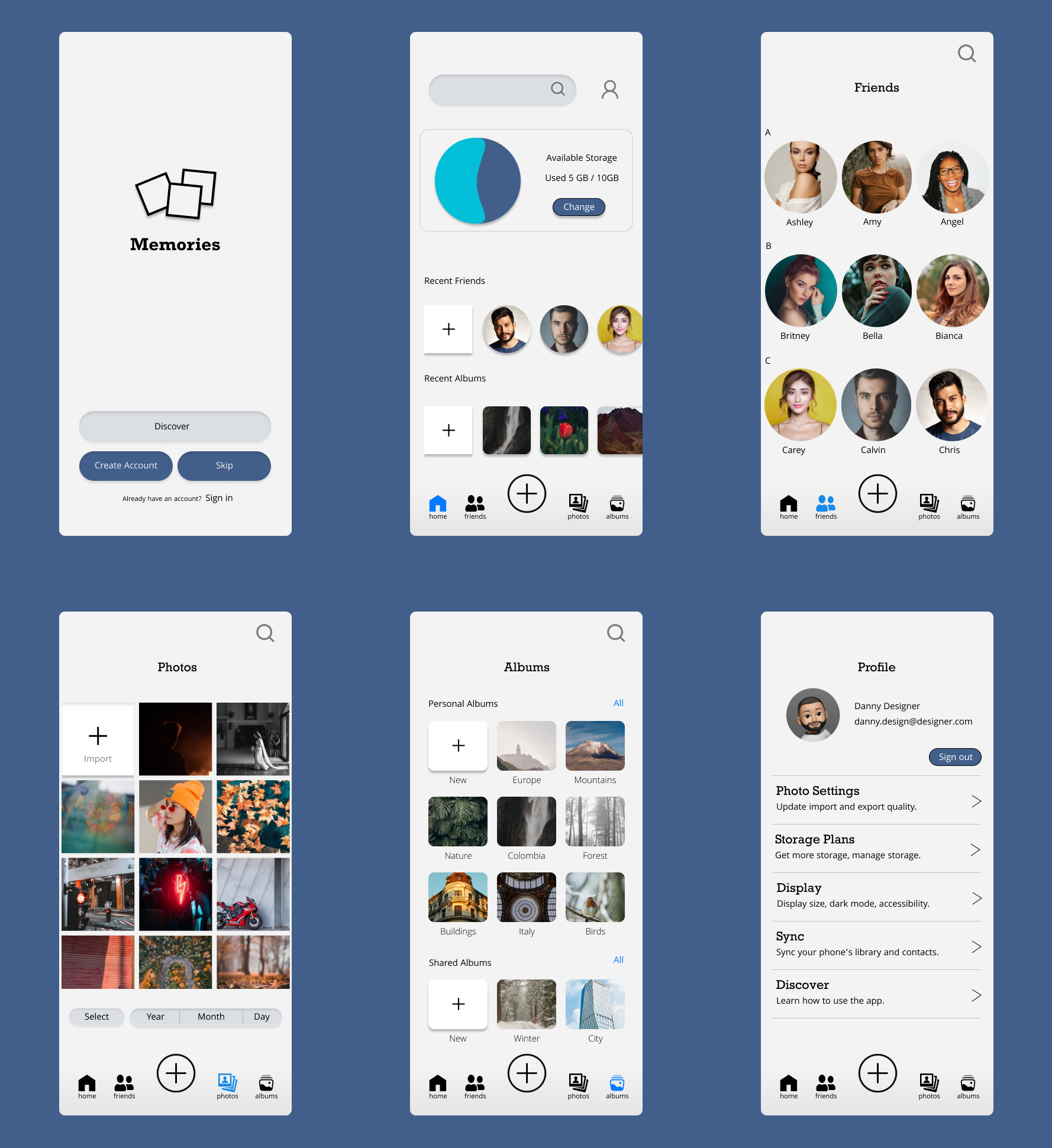Memories
Personal Project
Research / Branding / UX / UI
Figma / Adobe CC
Mobile (IOS) / Desktop
Problem
Sharing across IOS and Android has never been more difficult. Users don’t have a quick and easy way to share photos and videos without encountering reduced quality.
Solution
To provide users with a photo cloud-sharing app that integrates with their existing photo libraries so they can share memories with their friends instantly - whenever and wherever.
Deliverables
Weeks of initial research.
Brand identity & applications.
Mobile / desktop prototypes.
Project started in December 2023.

Research
Understanding user needs, I identified several critical factors. First, the app must boast a user-friendly interface facilitating effortless uploading, organizing, and sharing of photos. Robust privacy management tools are also imperative to empower users to control who can access their photos, safeguarding their data. Additionally, ensuring cross-platform compatibility is essential to enable users to access their photos seamlessly across various devices and platforms. These insights serve as invaluable guidance as I proceed with the design process, ensuring our app meets the diverse needs and expectations of my users.
In the research phase of this project, I encountered several user challenges. Notably, Apple's Airdrop and Google's Nearby Share set the standard for content sharing across iPhones and Androids, respectively.
Overcoming the hurdle of introducing a new data transfer method while unifying Apple and Android users under one seamless experience posed a significant challenge.
Pain Points
Loss of quality when transferring between devices
1
Certain apps or platforms may not be available on both platforms
2
Transferring large media files between Android and iPhone devices is time-consuming
3
Persona
Fareed is a 31-year-old software engineer living in Miami. He’s an avid traveler who leads with an active lifestyle.
Fareed Shora
Daily Life
Starts the day off with a morning run along the beachside.
Works remotely from home, and sometimes from a nearby cafe.
Spends time with friends after work by attending a local event or a dinner.
Challenges
Likes to take and share photos with his family who lives out of state, but they own Android devices which poses a challenge.
Because Fareed is a remote worker, he often travels and loves to take photos of his journeys. He wishes there was an easier way to automatically store and share his pictures with his travel buddies and people he meets along the way.
Ideation
During the ideation phase of developing "Memories," the photo cloud-sharing app, I embarked on a journey of conceptualization and design refinement. Beginning with pen and paper, I sketched wireframes to visualize the app's structure and flow. User flows served as crucial signposts, guiding me through the process of determining the necessary screens and interactions. As I delved deeper into the ideation process, I envisioned unique features that would set "Memories" apart.
One standout feature is the ability for users to designate themselves or others as admins when sharing photos or albums. This empowers users to control how content is viewed and stored, adding a layer of personalization and security. Additionally, seamless synchronization between the app and users' devices ensures that updates occur automatically, streamlining the sharing experience. Furthermore, "Memories" prioritizes quality by transferring photos and videos at their highest resolution by default, while also intelligently adapting files to the receiving device's settings and compatibility.
Lastly, the inclusion of "Proximity Share" allows for quick and convenient photo or album transfers via Bluetooth to individuals with the Memories app installed nearby, fostering instant connections and sharing moments effortlessly.

Iteration
In the design phase for "Memories," the process involved turning each photo cover for photos, albums, and friends into individual components connected as variants for easy selection. Inspired by the concept of memories resembling clouds in the sky—ever-passing and occasionally breathtaking—a neutral muted color palette was chosen. This palette not only adds visual appeal but also reflects the transient nature of memories.
Drawing upon insights gathered during the ideation phase, the design seamlessly integrates unique features like admin controls, automatic synchronization, and adaptive file transfer, prioritizing privacy and security through customizable settings.
Ultimately, the simplicity of the design aims to make reliving and sharing cherished memories effortless and delightful for users.
In leveraging the mobile-first design approach as a foundation, my goal was to ensure that both the desktop and responsive mobile experiences remained intuitive and recognizable, while also preserving a streamlined navigation system. This endeavour prompted a reevaluation of the placement and functionality of navigation elements and shortcut buttons, compelling a fresh perspective on their positioning at the top of the screen.
See it for yourself:
Mobile Prototype
Desktop Prototype

Outcomes
Reflection
During the development of this project, I gained valuable insights from research and peer reviews which contributed to the final designs.
Memories was birthed from the pain points my friends and I experienced while traveling abroad. I’m so proud to have built a solution to a problem that many users experience while sharing memories.
Updates
Completed on February 11th, 2024.
Website and responsive mobile completed on March 9th, 2024.
Iteration continues into February.










